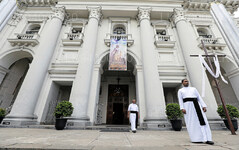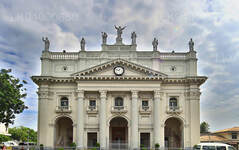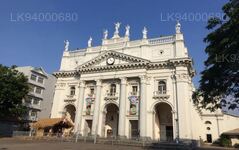
/páginas/transferências
Colombo, a capital do Sri Lanka, é uma cidade dinâmica que mistura tradição e modernidade. Ela exibe arquitetura colonial, mercados animados e templos budistas serenos. Com uma gastronomia diversificada, um horizonte crescente e belas praias, é um centro vibrante de negócios, cultura e turismo, oferecendo uma porta de entrada para explorar as maravilhas do Sri Lanka.
St Lucias Catherdral
St. Lucy of Sicily whose feast falls on December 13 is venerated the world over as the protectress against eye trouble. Legend has it that she had the most beautiful pair of eyes and that she pulled them out to present them to an unwelcome suitor who was enamored by their beauty. However, her eyes were miraculously restored to her more beautiful than before. Named after this virgin and martyr saint are St. Lucia’s Cathedral of Kotahena, the oldest and largest parish cathedral in Sri Lanka and the seat of the Archbishop of Colombo.
The 110-year-old cathedral had humble origins in a small chapel of wood and Cadjan built by the Oratorian fathers in 1760 when Ceylon was under Dutch occupation. This was replaced by a larger church of brick and mortar in 1782. When Ceylon was detached from the jurisdiction of the Archbishop of Goa in 1834, Rev. Fr. Vincenti Rosario was appointed the first Vicar-Apostolic of Ceylon and St. Lucia’s Cathedral became the first cathedral of Sri Lanka. Eventually, the foundation stone for a new cathedral building was laid to replace the old one. In 1873 Bishop H D Sillani and Rev. Fr. S Tabarrani, men of great vision and talent designed and initiated the building of St. Lucia’s Cathedral thus planting the seeds of grandeur and Lnagnificence of what was to be.
The Catholics of Colombo, the churches outside the city, and even the fisher folk contributed their share to the building fund. The cathedral cost Rs 160,000 to build which was an enormous amount in the last century, yet totally funded by the pious generosity of the Ceylonese Catholics of the time. Towards the end of 1887 the main body of the cathedral was completed and the blessing of the cathedral took place in December of that year. However the building of the cathedral took 30 years and was completed in 1902 when the scaffoldings were finally dismantled and the site cleared. The succeeding generations of parishioners and parish priests continued to embellish the cathedral with exquisite statues and sacred vessels often shipped from Europe. After a succession of European priests Rev. Fr. Nereus Fernando became the first Sri Lankan parish priest of the cathedral in 1956. Under the dynamic leadership of Rev. Fr. Rufus Benedict the cathedral was prepared for its centenary which was celebrated in December 1987. St. Lucia’s Cathedral Kotahena is the legacy of parishioners whose fervent faith aspired to build this magnanimous tribute to God. At the threshold of yet another century the cathedral stands unsurpassed in beauty and in magnificence as it has always stood over the last one hundred years.
Sobre o Distrito de Colombo
Colombo é a maior cidade e capital comercial do Sri Lanka. Está localizada na costa oeste da ilha e adjacente a Sri Jayewardenepura Kotte, a capital do Sri Lanka. Colombo é uma cidade movimentada e vibrante, com uma mistura de vida moderna e edifícios e ruínas coloniais, e uma população de 647.100 habitantes. A Região Metropolitana de Colombo, definida pelos distritos de Colombo, Gampaha e Kalutara, tem uma população estimada de 5.648.000 habitantes e cobre uma área de 3.694,20 km². Colombo é uma cidade multiétnica e multicultural. É a cidade mais populosa do Sri Lanka, com 642.163 habitantes vivendo dentro dos limites da cidade. A população de Colombo é uma mistura de vários grupos étnicos, principalmente cingaleses, mouros e tâmeis. Há também pequenas comunidades de pessoas de origem chinesa, portuguesa, holandesa, malaia e indiana vivendo na cidade, bem como numerosos expatriados europeus. A grande maioria das empresas cingalesas tem sua sede em Colombo. Algumas das indústrias incluem produtos químicos, têxteis, vidro, cimento, artigos de couro, móveis e joias. No centro da cidade está localizado o segundo edifício mais alto do sul da Ásia: o World Trade Center.
Sobre o Distrito de Colombo
A Província Ocidental é a província mais densamente povoada do Sri Lanka. Abriga a capital legislativa, Sri Jayawardenepura Kotte, e Colombo, o centro administrativo e comercial do país. A Província Ocidental é dividida em três distritos principais: Colombo (642 km²), Gampaha (1.386,6 km²) e Kalutara (1.606 km²). Como centro econômico do Sri Lanka, todas as grandes corporações locais e internacionais estão presentes na cidade, assim como todos os grandes estilistas e varejistas de rua. Portanto, prepare-se para se deliciar com as compras na Província Ocidental. Com a maior população de todas as províncias, quase todas as principais instituições de ensino da ilha estão localizadas na Província Ocidental. As universidades da província incluem a Universidade de Colombo, a Universidade de Sri Jayewardenepura, a Universidade de Kelaniya, a Universidade Aberta do Sri Lanka, a Universidade Budista e Pali do Sri Lanka, a Universidade de Defesa General Sir John Kotelawala e a Universidade de Moratuwa. A província ocidental tem a maior quantidade de escolas do país, que inclui escolas nacionais, provinciais, privadas e internacionais.







































